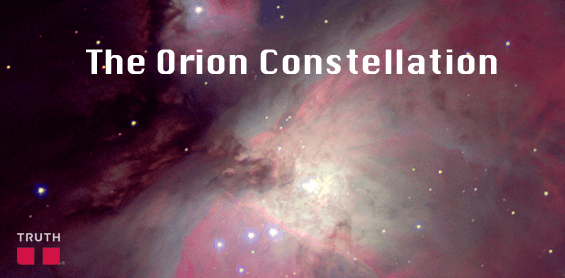Orion’s Belt is the name of one of the most recognizable star constellations in our night sky. When the lines between the stars are joined it looks like a stick figure of a person.
If you live in the northern hemisphere, you probably recognize the star constellation Orion, or the hunter!
An image showing the constellation Orion in Art. Credit: Wikipedia.
The star constellation Orion is among the most famous in the winter. If you’re in the Northern Hemisphere, you can spot Orion towards the northwest. And if you’re in the southern Hemisphere, you can spot it towards the southwest.
Although the stars that make up Orion look like they’re all at the same distance to us, each star is actually at a different distance! You can think of it this way, if you’re on a mountain top, looking down you’d see all the houses as if they’re close together and as if they’re all about the same distance away. But in reality, each house is at a different distance from the other house, and each house is at a different distance from the mountain.
What can I see when I look at Orion?
Here is an image showing the constellation Orion. Credit: NASA.
https://nssdc.gsfc.nasa.gov/image/astro/hst_betelgeuse.jpg
Looking at Orion, you can identify almost all the stars that make up the constellation. For example, Orion has a very obvious belt that consists of three stars named from left to right “Alnitak”, “Alnilam”, and “Mintaka”. All three names are Arabic names; “Alnitak” and “Mintaka” both mean belt in the Arabic language, and “Alnilam” means “string of pearls”.
You can also identify “the sword” of “the hunter” that consists of three stars as well, but a bit fainter than the stars at the belt. The location of Orion’s sword is also home to the famous Orion nebula (A nebula is a region in space where gases and dusts come together to make a new star.)
Here is an image showing Orion nebula credit: NASA.
Down the Orion nebula you will notice the hunter’s “knees”; two stars called “Rigel” and “Saiph” which also have an Arabic name origin, with “Rigel” meaning foot and “Saiph” meaning sword even though it’s not located where Orion’s sword is.
“Rigel” is also the brightest star in the Orion constellation with a surface temperature of 11,600 degrees Celsius (21,000 degrees Fahrenheit) and it’s 870 light years away from the Sun.
And up the hunter’s shoulders you will find the 2 stars “Betelgeuse” and “Bellatrix”, with “Betelgeuse” being the second brightest star in the constellation Orion, it has a surface temperature of 3300 degrees Celsius (6,000 degrees Fahrenheit), and it’s 642.5 light years away from Earth.
Is Betelgeuse going to supernova?
Throughout last year and the first few months of 2020, the Betelgeuse’s light as seen from Earth started to dim, so much so that scientists thought it was going to go supernova! But what is a supernova? And is it only exclusive to Betelgeuse?
Let’s start at the very beginning, you see stars have a life cycle as well; they live, they produce energy to continue on living, and they die out when they no longer can produce energy. And when a star is too massive, it dies with an explosion called a supernova that’s so big and bright that it outshines the light of their entire galaxy.
However, not all stars go supernova when they die, they must have a mass big enough, at least five times the mass of our Sun. And unfortunately, the odds of witnessing a supernova with the naked eye are not that great, astronomers have predicted that supernovae (Plural) happen in our Milky Way galaxy at a rate of two or three each century!
Since Betelgeuse’s dimming, astronomers have been trying to figure out the reason, and a new study finally did! Turns out, Betelgeuse is not going supernova anytime soon, and that the dimming was caused by a cloud of dust passing in front of the star and obscuring some of its light coming towards Earth. Next time you think dust is “just dust”, think again!
However, for those of you who are dying to witness a supernova, come back in the next 100,000 years when Betelgeuse is expected to explode, and you will see the brightest and greatest glare in the night sky ever. (it will also be visible during the daylight!!!)
Truth Belts released a new vegan men’s belt called Orion. You can check it out on Kickstarter. Once fully funded and available to the world, one tree will be planted with each Orion belt sold at www.truthbelts.com.

